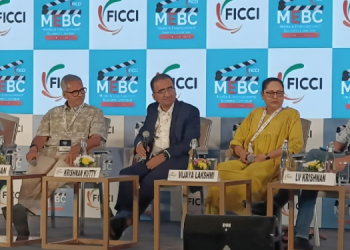Chennai: The rise of hybrid viewing through Android boxes has led to a 50% increase in total screen time per household, revealed L V Krishnan, Chief Executive Officer, TAM Media Research, during a panel discussion at FICCI MEBC South 2025. He added that Homes that previously averaged 2.5 hours of daily TV viewing now spend approximately 4.5 hours consuming a mix of linear and digital content.
Unwavering Dominance of Linear TV
L V Krishnan shared compelling insights into the TV consumption patterns in the South, highlighting that the region remains a stronghold for linear television. With nearly 75 million TV homes and a vast audience of 400 million, the South’s television viewership far surpasses other regions. Remarkably, about 65% of audiences engage with General Entertainment Channels (GECs) and movies daily, while 80% tune in weekly for popular soap operas and non-fiction weekend programming.
This level of engagement contrasts starkly with North and West India, where TV reach has declined to around 45%. The key factor driving this loyalty is content—its quality, accessibility, and affordability. The power of regional storytelling continues to captivate audiences, making South Indian content highly sought after even beyond regional boundaries.
The Coexistence of Streaming and Linear TV
Contrary to the belief that streaming platforms are overtaking traditional television, Krishnan revealed that both mediums are growing simultaneously. The rise of hybrid viewing through Android boxes has led to a 50% increase in total screen time per household. Homes that previously averaged 2.5 hours of daily TV viewing now spend approximately 4.5 hours consuming a mix of linear and digital content.
The panel also discussed the audience overlap between linear TV and streaming. Viewers increasingly use streaming platforms for catch-up viewing, particularly for episodic content. The habit of watching two to three episodes weekly on TV, followed by binge-watching the rest via streaming, has led to a significant boost in overall content consumption.
Investment in Content: The Driving Force
Krishnan emphasized the crucial role of storytelling in keeping audiences engaged. He recounted an example of a Korean show adapted for Hotstar, which sparked conversation due to cultural shifts in content portrayal. This highlighted that audience expectations in the South remain deeply rooted in cultural sensibilities despite growing exposure to international content.
Furthermore, the export of South Indian content to Hindi and other markets signifies its increasing influence. Regional storytelling formats are being adapted into mainstream television and films across India, showcasing the potential for further content-driven expansion.
Advertising and Revenue: The Strength of TV
Despite the rapid growth of digital advertising, television remains a lucrative platform for advertisers. Krishnan noted that there are approximately 4,000 advertisers on television, with 75% of them exclusively advertising on TV. This demonstrates the strong return on investment and trust in the medium’s reach and effectiveness.
Broadcasters must continue to nurture relationships with advertisers, ensuring that television remains a preferred choice for brand visibility and audience engagement.
The Future: Aggregation and Platform Evolution
Looking ahead, Krishnan predicted a shift towards content aggregation. Platforms like JioStar and Hotstar are evolving beyond traditional broadcasting and streaming to become comprehensive content hubs. Since nearly 75% of content remains consistent across platforms, the technological mode of delivery will become secondary to the strength of storytelling.
The South Indian television industry’s resilience is a testament to its compelling content, strong audience loyalty, and strategic innovation. As streaming continues to grow alongside linear TV, the industry must focus on creating high-quality regional content, embracing hybrid viewing patterns, and optimizing advertising strategies. With its formidable reach and ever-evolving landscape, South Indian television is poised to remain a dominant force in the entertainment ecosystem for years to come.

















